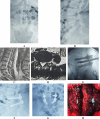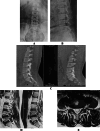Can minimally invasive transforaminal lumbar interbody fusion achieve a better clinical and radiological outcome than traditional open technique in isthmic spondylolisthesis?
- PMID: 39210403
- PMCID: PMC11360516
- DOI: 10.1186/s13018-024-04994-4
Can minimally invasive transforaminal lumbar interbody fusion achieve a better clinical and radiological outcome than traditional open technique in isthmic spondylolisthesis?
Abstract
Background: Spondylolisthesis is a prevalent condition in the lumbar spine that can cause low back pain, leg pain, neurogenic claudication, and impact health-related quality of life in symptomatic individuals.
Aim: to assess the results of minimally invasive TLIF (MIS-TLIF) versus open-TLIF and the impact of correcting spino-pelvic parameters on the Health-Related Quality of Life (HRQoL) in patients with low-grade isthmic spondylolisthesis. The primary objective was to compare the effectiveness of both methods in correcting spinopelvic parameters. The secondary objectives involved comparing clinical improvement, operating time, blood loss, complications, and postoperative hospital stays between the two procedures.
Patients and methods: Seventy-two patients with low-grade isthmic spondylolisthesis were enrolled in this retrospective cohort-control study, with a minimum follow-up period of 18 months. Disability was assessed using the Oswestry Disability Index (ODI), while back and leg discomfort were rated using the Visual Analogue Scale (VAS) for each patient. The measurements comprised the sacral slope (SS), pelvic tilt (PT), pelvic incidence (PI), and Meyerding slip grades. We measured lumbar lordosis (LL), and segmental lordosis.
Results: The seventy-two patients were 60 female and 12 males. There was no statistically significant difference in the duration of operation between the two groups. In the MIS group, there was a notable reduction in blood loss, higher radiation exposure, and a shorter hospital stay (P < 0.001). The back VAS showed more favorable outcomes in the MIS-TLIF, while the leg VAS showed better results in the Open-TLIF in the early outcome. Both procedures significantly reduced leg and back pain VAS scores and ODI, with no notable difference between the two groups at the final follow-up. Post-surgery, the pelvic incidence (PI) and lumbar lordosis (LL) matched properly in all patients, showing a rise in LL and sacral slope along with a decrease in pelvic tilt.
Conclusion: Both open-TLIF and MIS-TLIF are effective methods for correcting spino-pelvic parameters and improving HRQoL in patients with low-grade isthmic spondylolisthesis. The rapid improvement in back pain experienced by these patients favored the use of MIS-TLIF. However, the cost-effectiveness of this approach must be carefully evaluated.
Keywords: Isthmic spondylolitheisis; MIS-TLIF; Minimal invasive; Spino-pelvic parameter.
© 2024. The Author(s).
Conflict of interest statement
The authors declare that they have no competing interests.
Figures







References
-
- Pawar A, Labelle H, Mac-Thiong JM. The evaluation of lumbosacral dysplasia in young patients with lumbosacral spondylolisthesis: comparison with controls and relationship with the severity of slip. Eur Spine J. 2012;21(11):2122–7. 10.1007/s00586-012-2181-7. 10.1007/s00586-012-2181-7 - DOI - PMC - PubMed
-
- Heemskerk JL, Oluwadara Akinduro O, Clifton W, Quiñones-Hinojosa A, Abode-Iyamah KO. Long-term clinical outcome of minimally invasive versus open single-level transforaminal lumbar interbody fusion for degenerative lumbar diseases: a meta-analysis. Spine J. 2021;21(12):2049–65. 10.1016/j.spinee.2021.07.006. 10.1016/j.spinee.2021.07.006 - DOI - PubMed
Publication types
MeSH terms
LinkOut - more resources
Full Text Sources
Research Materials
Miscellaneous

